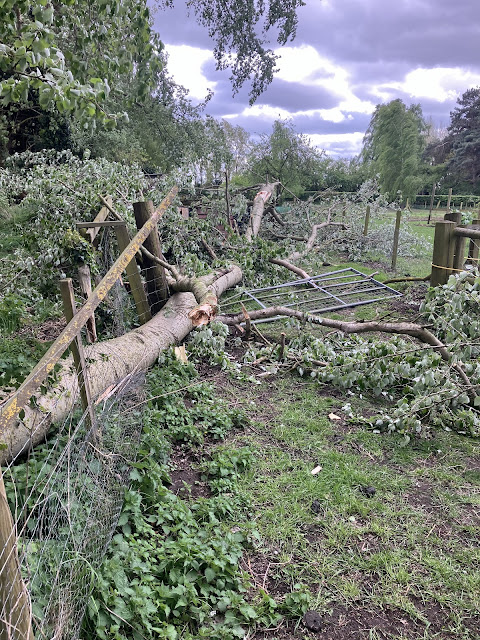After a welcomely clement weekend it has turned cold again. Yesterday we had very strong winds and intermittent rain and hailstones. Not so nice for us nor for any tender plants beginning to poke their heads above the soil.
We also had a large poplar tree go down on our boundary. This is the third tree on our holding to fall due to the weather since last Autumn. We have occasionally lost a tree during a storm but three in a short space of time is a bit of a niusance to say the least. It involves a lot of chainsawing and clearing up afterwards, and also the task of processing the debris. There is a lot of brush to dispose of whilst the logs suitable for the log burner have to be stored somewhere to dry out and season. With three trees down in a relatively short space of time this is proving a challenge.
When we lose a boundary tree they usually fall on to the neighbouring farmer's field. He has been most helpful in helping to deal with it, inluding pulling the tree clear of the boundary dyke with a tractor. The trees tend to fall his way because of the direction of the prevailing winds and the way the trees lean. Yesterday's tree, which was about eighty feet high, fell in our direction, however. The photograph below shows the top half of the tree. Apart from clearing the tree there is some fencing that needs replacing as well a metal field gate which took a battering. It is rather a distraction in what is a busy time of the year on the smallholding.
At the same time there is a tinge off sadness for what was a substantial tree and the space it once filled. Although I would not regard this poplar as a 'Great Tree' it does bring to mind a poem by Maya Angelou.
When Great Trees Fall
By Maya Angelou
When great trees fall,
rocks on distant hills shudder,
lions hunker down
in tall grasses,
and even elephants
lumber after safety.
When great trees fall
in forests,
small things recoil into silence,
their senses
eroded beyond fear.
When great souls die,
the air around us becomes
light, rare, sterile.
We breathe, briefly.
Our eyes, briefly,
see with
a hurtful clarity.
Our memory, suddenly sharpened,
examines,
gnaws on kind words
unsaid,
promised walks
never taken.
Great souls die and
our reality, bound to
them, takes leave of us.
Our souls,
dependent upon their
nurture,
now shrink, wizened.
Our minds, formed
and informed by their
radiance, fall away.
We are not so much maddened
as reduced to the unutterable ignorance of
dark, cold
caves.
And when great souls die,
after a period peace blooms,
slowly and always
irregularly. Spaces fill
with a kind of
soothing electric vibration.
Our senses, restored, never
to be the same, whisper to us.
They existed. They existed.
We can be. Be and be
better. For they existed.








.jpg)



.jpg)












%20-%20Van%20Gogh%20Wiki.jpg)


